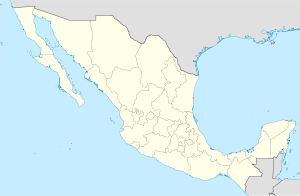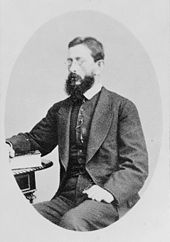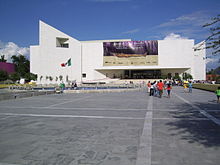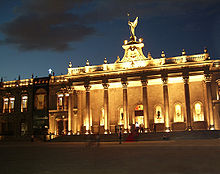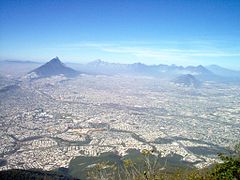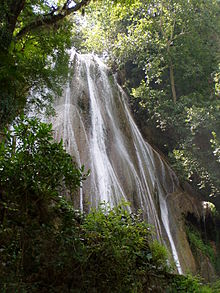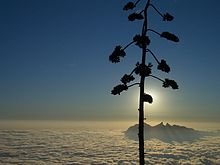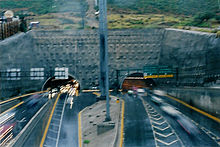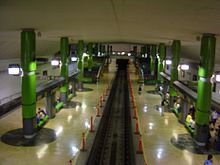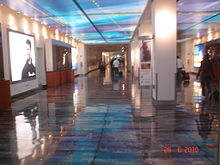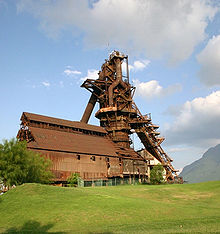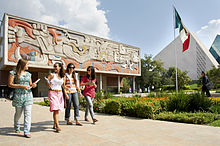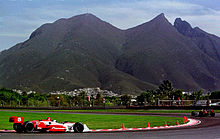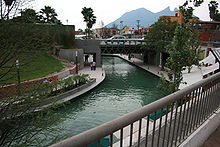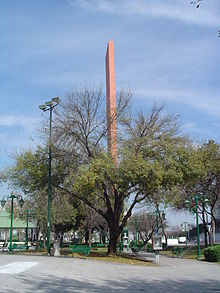- Monterrey
-
This article is about the Mexican city. For other uses, see Monterrey (disambiguation).
Monterrey — City — Ciudad de Monterrey
City of MonterreyDifferent locations of the Metropolitan Area of Monterrey. 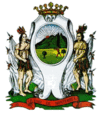
Coat of armsNickname(s): Sultan of the North, The City of the Mountains Motto: Work Tempers the Spirit Location of Monterrey in Mexico Coordinates: 25°40′N 100°18′W / 25.667°N 100.3°W Country Mexico State Nuevo León Founded September 20, 1596 Government – Mayor Fernando Larrazábal Bretón
(PAN)Area – City 969.70 km2 (374.4 sq mi) – Metro 5,346.80 km2 (2,064.4 sq mi) Elevation 537 m (1,762 ft) Population (2010) – City 1,130,960 – Density 2,532/km2 (6,557.8/sq mi) – Metro 4,080,329 – Metro density 923/km2 (2,390.6/sq mi) – Demonym Regiomontano(a)
Regio(a)Time zone CST.[1] (UTC−6) – Summer (DST) CDT[1] (UTC−5) Website (Spanish) Official Monterrey Government Website Monterrey (Spanish pronunciation: [monteˈrei] (
 listen)), is the capital city of the northeastern state of Nuevo León in the country of Mexico.[1] The city is anchor to the third-largest metropolitan area in Mexico[2][3] and is ranked as the ninth-largest city in the nation. Monterrey serves as a commercial center in the north of the country and is the base of many significant international corporations.[4] Until recently, the city had long been regarded as the safest in Mexico and one of the safest in Latin America.[4] Furthermore, Monterrey is Mexico's second richest city, and the world's 63rd richest, with an economy that had a 2008 GDP of USD $102 billion.[5] Monterrey is one of Mexico's most developed cities, with the highest per capita income in the nation, and is regarded as a highly developed city.[3][4] Although rich in history and culture, Monterrey is often regarded as the most "Americanized" city in entire country, even above the cities along the U.S-Mexico border.[6]
listen)), is the capital city of the northeastern state of Nuevo León in the country of Mexico.[1] The city is anchor to the third-largest metropolitan area in Mexico[2][3] and is ranked as the ninth-largest city in the nation. Monterrey serves as a commercial center in the north of the country and is the base of many significant international corporations.[4] Until recently, the city had long been regarded as the safest in Mexico and one of the safest in Latin America.[4] Furthermore, Monterrey is Mexico's second richest city, and the world's 63rd richest, with an economy that had a 2008 GDP of USD $102 billion.[5] Monterrey is one of Mexico's most developed cities, with the highest per capita income in the nation, and is regarded as a highly developed city.[3][4] Although rich in history and culture, Monterrey is often regarded as the most "Americanized" city in entire country, even above the cities along the U.S-Mexico border.[6]Monterrey as an important industrial and business center hosts an array of Mexican companies, including Pemex, Lanix Electronics, CEMEX, Vitro, Zonda Telecom, Mercedes-Benz-Valdez, OXXO, Mastretta, BMW de Mexico, Mabe Grupo Bimbo, Zihuatanejo Jet Engines S.A. de C.V. DINA S.A., Cuauhtémoc Moctezuma Brewery (Cervecería Cuauhtémoc Moctezuma), formerly fully owned by FEMSA now jointly owned with Heineken[7][8] and Alestra Telecommunications. Monterrey is also home to international companies such as Sony, Toshiba, Carrier, Whirlpool, Samsung, Toyota, Hummer, Daewoo, Ericsson, Nokia, Dell, Boeing, HTC, General Electric, Gamesa, LG, SAS Institute and Teleperformance, among others.[3][9][10]
Monterrey is located in northeast Mexico, at the foothills of the Sierra Madre Oriental. The recorded history of Monterrey starts in 1596, with its founding by Diego de Montemayor. In the years after the Mexican War of Independence, Monterrey became an important business center. With the establishment of Fundidora Monterrey, the city experienced industrial growth.
Contents
History
- See also articles in the category History of Monterrey
See also: History of Nuevo LeónPrehispanic history
Prior to the European foundation of the city, there was no established nation state, and the population instead consisted of some indigenous semi-nomad groups that are collectively called Chichimecas. Carved stone and cave painting in surrounding mountains and caves have allowed historians to identify four major groups in present-day Monterrey: Azalapas, Huachichiles, Coahuiltecos and Borrados.[11]
Foundation
 Foundation of Monterrey, painting by Crescenciano Garza Rivera. The city was founded on September 20, 1596 by Diego de Montemayor.
Foundation of Monterrey, painting by Crescenciano Garza Rivera. The city was founded on September 20, 1596 by Diego de Montemayor.
In the 16th century, the valley in which Monterrey is located was known as the Extremadura Valley, an area largely unexplored by the Spanish colonizers. The first expeditions and colonization attempts were led by Alberto del Canto, naming the city Santa Lucia, but were unsuccessful because the population was attacked by the natives and fled. The Spanish expeditionary Luis Carvajal y de la Cueva negotiated with King Philip II of Spain to establish a territory in northern New Spain, which would be called Nuevo León, the "New Kingdom of León". In 1580 he arrived in the newly granted lands but it was not until 1582 that he established a settlement called San Luis Rey de Francia within present-day Monterrey. The New Kingdom of León extended westwards from the port of Tampico to the limits of Nueva Vizcaya ("New Vizcaya", now State of Chihuahua), and around 1,000 kilometers northwards. For eight years Nuevo León was abandoned and uninhabited, until a third expedition of thirteen families led by Diego de Montemayor founded Ciudad Metropolitana de Nuestra Señora de Monterrey ("Metropolitan City of Our Lady of Monterrey") on September 20, 1596, next to a water spring called Ojos de Agua de Santa Lucia, where the Museum of Mexican History and Santa Lucía Riverwalk are now located.
During the years of Spanish rule, Monterrey remained a small city, and its population varied from a few hundred to only dozens. The city was a place that facilitated trade between San Antonio (now in Texas), Tampico and from Saltillo to the center of the country. Tampico's port brought many products from Europe, while Saltillo concentrated the Northern Territories' trade with the capital, Mexico City. San Antonio was the key trade point with the northern foreign colonies (British and French).
After Mexican Independence (19th century)
In the 19th century, after the Mexican Independence War, Monterrey rose as a key economic center for the newly formed nation, especially due to its balanced ties between Europe (with its connections to Tampico), the United States (with its connections to San Antonio), and the capital (through Saltillo). In 1824, the "New Kingdom of León" became the State of Nuevo León, and Monterrey was selected as its capital. However, the political instability that followed the first 50 years of the new country allowed two American invasions and an internal secession war, during which the Governor of the State annexed the Coahuila and Tamaulipas states, designating Monterrey as the capital of the enlarged state.
In 1846, the earliest large-scale engagement of the Mexican-American War took place in the city, known as the Battle of Monterrey. Mexican forces were forced to surrender but only after successfully repelling US forces during the first few advances on the city. The battle inflicted high casualties on both sides, much of them resulting from hand-to-hand combat within the walls of the city center.
Most of the generals in the Mexican War against France were natives of the city, including Mariano Escobedo, Juan Zuazua and Jerónimo Treviño.
Contemporary history
During the last decade of the 19th century, the city of Monterrey was linked by railroad, which benefitted industry. It was during this period that José Eleuterio González founded the University Hospital which is now one of the best public hospitals in the northeast of Mexico, and serves as medical school support to the School of Medicine of the Autonomous University of Nuevo León (UANL). Antonio Basagoiti and other citizens founded the Fundidora de Fierro y Acero de Monterrey,[12] in 1900, a steel-producing company that accelerated the already fast industrialization of the city and became one of the world's biggest of its time. In 1986, several official games of the 1986 FIFA World Cup were hosted.
In 1988, Hurricane Gilbert caused great damage to the city; the Santa Catarina River overflowed, causing about 100 deaths and economic damage.
The city has hosted international events such as the 2002 United Nations Conference on Financing for Development with the participation of more than 50 heads of state and government, as well as other ministers and senior delegates from over 150 countries. The conference resulted in the adoption of the Monterrey Consensus, which has become one relevant reference point for international development and cooperation. In 2004, the OAS Special Summit of the Americas was attended by almost all the presidents of the Americas.
In 2007, Monterrey held the Universal Forum of Cultures with four million visitors.In 2008, Monterrey held the FINA World Junior Championships.
In 2010, Monterrey was hit by another damaging storm, Hurricane Alex. Alex was considered worse than Hurricane Gilbert, with record breaking rain bringing floods, and causing severe economic damage. Damage estimates totaled $1.885 billion USD, and in $16.9 billion MXN. After this event the city is under reconstruction and urban renewal. Recently, the project Nuevo León Development Plan 2030 was presented, along with some other metropolitan projects.[citation needed]
In August 2011 the city was the scene of a terror attack, in which more than 50 people were killed. This was the first big conflict of rivaling drug gangs in the city that had been so far spared.
Governance
Main article: Politics and government of Nuevo LeónMonterrey and its metropolitan area are municipalities each of them governed by a democratically elected Presidente Municipal (Municipal President) or Mayor for a period of three years with no right to reelection. The political environment is one of civility and in the last decade political parties have been alternating office. The current Mayor of Monterrey is Fernando Larrazábal.
The City Council of Monterrey (Cabildo de Monterrey) is an organ integrated by the Mayor, the Regidores and the Síndicos. The Mayor is the executor of the determinations of the City Council and the person directly in charge of the public municipal administration. The Regidores represent the community and their mission is to collectively define the city policies in all the subjects affecting it. The Síndicos are in charge of watching and legally defending the city interests, as well as in charge of watching the City Treasury status and the municipal patrimony.[13]
The political parties with representation in the city are the Institutional Revolutionary Party or PRI, the National Action Party or PAN, the Party of the Democratic Revolution or PRD, the Labor Party or PT, the Green Party, Convergence, Socialdemocratic Party and Nueva Alianza.
Public safety
Main article: Mexican Drug WarIn 2005, Monterrey was ranked as the safest city in Latin America[14] and Mexico, and one of the two safest in 2006. However, since 2008 the city has experienced violence related to turf battles between warring drug cartels in Mexico. The year 2010 has been the most violent in history. Drug dealers are a major concern, although military offensives and police captures of important drug-cartel chiefs have weakened drug cartels trying to settle in the city. The city is safe to travel by day and night; nevertheless, precaution and common sense should be considered in certain districts at night.[15][16][17]
There are two police departments guarding the city, the Police of the City of Monterrey (locally known as the Policía Regia),[18] dependent of the municipal government, and the State Public Safety.[19] The Policía Regia protects the city's downtown and main areas, while the State Public Safety is in charge of the farthest areas.
Geography
The city of Monterrey is located at 25°40′N 100°18′W / 25.667°N 100.3°W, and 530 metres (1,740 ft) above sea level in the northeastern Mexican state of Nuevo León. The Santa Catarina River—dry most of the year on the surface but with flowing underground water—bisects Monterrey from East to West, thus separating the city into north and south halves.
Monterrey is adjoined to San Nicolás de los Garza, García and General Escobedo to the north; Guadalupe, Juárez and Cadereyta Jiménez to the east; Villa de Santiago to the south; and San Pedro Garza García and Santa Catarina to the west.[20]
Monterrey lies north of the foothills of the Sierra Madre Oriental mountain range. A small hill, the Cerro del Topo and the smaller Topo Chico are located in the suburbs of San Nicolás de los Garza and Escobedo. West of the city rises the Cerro de las Mitras (Mountain of the Mitres), which resemble the profile of several bishops with their mitres.
Cerro de la Silla (Saddle Mountain) dominates the view east of the city. Cerro de la Loma Larga—South of the Santa Catarina river—separates Monterrey from the suburb of San Pedro Garza García. At the summit of the Cerro del Obispado, north of the river, is the historic Bishopric Palace, site of one of the most important battles of the Mexican-American War.
Natural areas
The mountains surrounding Monterrey contain many canyons, trails and roads that cross deserts and forests. Suitable trails are available to the general public. The Sierra Madre Oriental mountains south of the city are included in the "Parque Nacional Cumbres de Monterrey" (National Park), which was added to UNESCO’s Man and the Biosphere (MAB) Program of Biosphere Reserves in 2006.[21]
Cumbres de Monterrey includes:
- Parque Ecológico Chipinque,[22] which contains forested areas (oak and oak-pine mainly).[23][24][25]
- La Estanzuela state park, about 7 km (4 mi) south of Monterrey, a river and forested area.[26]
- La Huasteca, west of the city, in the municipality of Santa Catarina.
- El Potrero Chico Climbing Area, north east of the city, in the municipality of Hidalgo.
Climate
Monterrey Climate chart (explanation) J F M A M J J A S O N D 0.368500.472530.380560.786640.890691.893741.195752.895754.190731.982640.575560.47252Average max. and min. temperatures in °F Precipitation totals in inches Source: Weather.com / NWS Metric conversion J F M A M J J A S O N D 7.620101022127.627131830182032214634232835247135241043223482818132413102211Average max. and min. temperatures in °C Precipitation totals in mm Monterrey is known for its hot weather in summer reaching 40 °C (104 °F) or more for three consecutive months, being one of the warmest major cities in Mexico.[27]
Monterrey has a semi-arid climate (Köppen climate classification BSh). Its weather is temperate in spring and autumn and is hot in the summer. The average high in August is 35 °C (95 °F) and the average low is 23 °C (73 °F). Winters are mild. The average January high is 20 °C (68 °F) and the average low in January is 10 °C (50 °F); temperatures below freezing are rare.[28] Rainfall is scarce, but more prominent during May through September. Monterrey is very extreme in weather change, sometimes reaching 30 °C (86 °F) in January and February, despite the fact that these are the coldest months. Most extreme weather change occurs with rainfall in summer, which changes extreme heat to cooler temperatures, and the absence of northern winds in winter, sometimes causing extreme or abnormally high temperatures. Seasons are not well defined, the warm season can start in February and last until September. Snow is a very rare event, although an accumulation of 20 inches (51 cm) in 8 hours occurred in January 1967.[29] The most recent snowfall was in December 2004. Several sleet and ice events have occurred during January 2007, December 2009, January and February 2010 and February 2011, caused by temperatures around −5 °C (23 °F). In April and May 2011 temperatures reached 45 °C (113 °F) or more, causing fires and extreme heat in the city, despite the fact that these months are in spring. During June 30 – July 2 of 2010, Monterrey was hit by the worst natural disaster in the city's history when Hurricane Alex delivered more than 23 inches of rain around 72 hours with areas reaching up to 1 meter of rain during that same period destroying homes, avenues, highways and infrastructure leaving up to 200,000 families without water for a week or more. The amount of water that fell is equivalent to the average precipitation for a year period. This was about 3–4 times as much rain as when Hurricane Gilbert arrived to the city on September 15, 1988. The death toll of Hurricane Alex was estimated to be around 20.
Cityscape
See also: List of tallest buildings in MonterreyMonterrey has several neighborhoods. Most populous include:
- Independencia
- Cumbres and its different sectors
- Obispado
- Contry
- Mitras Centro, Norte & Sur
- San Jerónimo
- San Bernabé
- Valle Alto
- Valle
- Vista Hermosa
- Anáhuac
Demographics
Monterrey
population by year1798 7,000 1833 13,645 1846 15,000 1852 13,534 1862 14,534 1869 14,000 1881 40,000 1890 41,700 1900 62,266 1910 78,528 1921 88,479 1930 132,577 1940 206,152 1950 375,040 1960 708,399 1970 1,246,181 1990 2,213,711 1995 2,516,658 2005 3,864,331 2010 4,080,329 *Note: Figures from 1970–2010, include municipalities of Monterrey metropolitan area
References:[30][31][32][33][34] According to the national INEGI population census of 2010, of the total population of the state of Nuevo León, 87.3% lived in the Monterrey metropolitan area.[30][30][31][32][33][34]
The Monterrey metropolitan area is the third most populous city in Mexico with more than 4 million. It is composed of the adjoined municipalities of Monterrey, Apodaca, Escobedo, García, Guadalupe, Santiago, Juárez, San Nicolás de los Garza, San Pedro Garza García, and Santa Catarina.[35]
Infrastructure
Transportation
- See also articles in the category: Transportation in Monterrey
Monterrey is connected with the USA border, the sea and inland Mexico through different roads, including the Carretera Nacional (also known as the Panamerican Highway) that runs from Nuevo Laredo to Mexico City and south, and the Carretera Interoceánica connecting Matamoros with the port of Mazatlán on the Pacific; it is also crossed by highways 40, 45, 57. The divided highway Monterrey-Saltillo-Matehuala-Mexico City is the main land corridor to interior Mexico.
There are several between-cities bus lines at the bus station downtown. There are arrivals and departures into deeper Mexico, to the U.S. border and into the United States.
Monterrey is also connected by at least three important railroad freight lines: Nuevo Laredo-Mexico City, Monterrey-Tampico, and Monterrey-Pacific (Mazatlán).
The city has a rapid transit system called Metrorrey, which currently has 2 lines.[36][37]
The city is served by two international airports: General Mariano Escobedo International Airport (served by major international carriers and moving more than 6.5 million passengers in 2007)[38] and Del Norte International Airport, a primarily private airport.
Monterrey is linked through frequent non-stop flights to many Mexican cities and to key United States hubs (Atlanta, Chicago-O'Hare, Dallas/Fort Worth, Detroit, Houston-Intercontinental, JFK/New York, and Las Vegas). Monterrey is the second most important city for the operating routes of Aeroméxico.[39]
Five airlines have their operational bases and headquarters in Monterrey, Aviacsa, Aeroméxico Connect, VivaAerobus and Magnicharters. There is no public transportation from Monterrey International Airport to the city. However, a cartel of taxi services link the airport with the city and charge around $20 US for a one-way ride to the city. From this airport, there is a bus shuttle to nearby Saltillo. Inter-city bus services run daily into the interior, as well as north to the US border and points beyond.
Health
Monterrey generally has a very high ranked medical infrastructure with some internationally acclaimed hospitals,[40] including three with Joint Commission accreditation[41] the Joint Commission is a private healthcare accreditation group. There are both public and private hospitals. The Mexican Social Security Institute (IMSS) has two major regional hospitals in the city, the Specialties Regional Hospital # 33 and the Gynecology and Obsterics Regional Hospital, serving also the northeastern states of Coahuila and Tamaulipas. Several smaller IMSS hospitals can be found such as the Traumatology and Orthopedics Hospital and the General Hospital # 25. State government owns the Metropolitan Hospital, located in the suburb of San Nicolás de los Garza and the Hospital of the Children and Mother Care in Guadalupe suburb.
The Autonomous University of Nuevo León runs the public University Hospital, with a high-level shock-trauma unit and a specialized clinic for child cancer treatment. It is recognized as the best public hospital in the northeast of Mexico and the UANL School of Medicine as one of the best in the country. On the other hand the Tecnológico de Monterrey runs the Hospital San José-Tec de Monterrey private hospital.
Monterrey has healthcare standards above the average for Mexico.[42] It has several hospitals, including Hospital Cima (formerly Santa Engracia) of the International Hospital Corporation. Its convenient location, low prices and quality of medical care have made of Monterrey a very popular medical tourism destination for United States patients.[43]"JCI Spotlight Stories: OCA Hospital, Monterrey, Mexico – Joint Commission International". jointcommissioninternational.org. http://www.jointcommissioninternational.org/JCI-Spotlight-Stories-OCA-Hospital-Monterrey-Mexico/. Retrieved July 18, 2009.
Economy
See also: Category:Companies based in Monterrey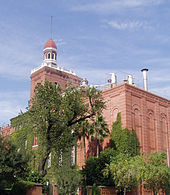 Cuauhtémoc Moctezuma Brewery (Cervecería Cuauhtémoc Moctezuma)
Cuauhtémoc Moctezuma Brewery (Cervecería Cuauhtémoc Moctezuma)
Monterrey is a major industrial center in northern Mexico, producing a GDP of 78.5 billion US dollars[44] (2006). The city's GDP per capita in 2010 was $607,042 Mexican pesos or $46,634 US dollars. The city was rated by Fortune magazine in 1999 as the best city in Latin America for business and is currently ranked third best by the América Economía magazine.[45]
Because of its strong steel industry, it is often called "the Pittsburgh of Mexico".[46] The city has prominent positions in sectors such as steel, cement, glass, auto parts, and brewing. The city's economic wealth has been attributed in part to its proximity with the United States-Mexican border and economic links to the United States.[45][47]
Industrialization was accelerated in the mid 19th century by the Compañia Fundidora de Fierro y Acero Monterrey, a steel-processing company.[48] Today, Monterrey is home to transnational conglomerates such as Cemex (the world's third largest cement company),[49] FEMSA (Coca-Cola Latin America), Alfa (petrochemicals, food, telecommunications and auto parts), Axtel (telecommunications), Vitro (glass), Selther (leading mattress and rest systems firm in Latin America), Gruma (food), and Banorte (financial services). The FEMSA corporation owned a large brewery, the Cuauhtémoc Moctezuma Brewery (Cervecería Cuauhtémoc Moctezuma) that produces the brands Sol, Tecate, Indio, Dos Equis and Carta Blanca among others, in the beginning of the year Cuauhtémoc Moctezuma Brewery was sold to Dutch-based company Heineken. By the end of the same year, there were more than 13,000 manufacturing companies, 55,000 retail stores, and more than 52,000 service firms in Monterrey.[50]
The metals sector, dominated by iron and steel, accounted for 6 percent of manufacturing GNP in 1994.[51] Mexico's steel industry is centered in Monterrey, where the country's first steel mills opened in 1903. Steel processing plants in Monterrey, privatized in 1986, accounted for about half of Mexico's total steel output in the early 1990s.[51]
Monterrey was ranked 94th worldwide and fifth in Latin America in terms of Quality of Life according to Mercer Human Resource Consulting (2006),[52] and was ranked second in 2005 and fourth in 2006, according to America Economia.
Some of the shopping malls in the city include Paseo San Pedro, Plaza Fiesta San Agustín, Galerías Monterrey, and Galerías Valle Oriente, which distribute goods and services to the Mexican population.
Education
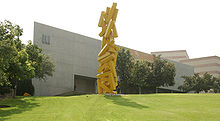 Campus Universidad de Monterrey
Campus Universidad de Monterrey
Monterrey has an estimated 3.7% rate of illiteracy. In 2005, from an estimated 983,359 inhabitants above 6 years of age, 36,689 were illiterates.[53]
In 2005, the city had 72 public libraries, with 298,207 books available, serving an estimated 478,047 readers.[53]
Monterrey is also the headquarters of the Instituto Tecnológico y de Estudios Superiores de Monterrey (Monterrey Institute of Technology and Higher Studies, ITESM or "Tec de Monterrey") one of the most important universities in Mexico.[54]
The Universidad Autónoma de Nuevo León (Autonomous University of Nuevo León, UANL), is the third largest Mexican university and is ranked by the Reader's Digest-AC Nielsen Survey 2005 as the top public university in northeast Mexico.[55] Its main campus, Ciudad Universitaria (University City), covers approximately 67,630,000 square metres (17,000 acres).[56] The UANL system comprises 26 colleges (faculties), 22 graduate divisions, 24 high schools, 1 center of bilingual education and 3 technical high schools. The medical school of the UANL is considered one of the most advanced in Latin America.[57]
Founded in 1969 with the support of local leading multinational corporations such as Cemex, Alfa, Femsa, Gamesa, Protexa & CYDSA, the Universidad Regiomontana is a private university offering high school, undergraduate and graduate programs. With agreements with more than 200 universities across the globe, it is member of GATE (Global Alliance for Transnational Education), FIMPES (Federación de Instituciones Mexicanas Particulares de Educación Superior) and holds an ISO 9001 Certification. Its urban campus attracts many working professionals who complement and enrich the academic experience.
The Universidad de Monterrey was founded by the religious congregations of the Sisters of Immaculate Mary of Guadalupe, the nuns of the Sacred Heart and the Marist and La Salle brothers, all of them supported by an association of catholic citizens.[58] On December 2001 was accredited by the Southern Association of Colleges and Schools (SACS) to deliver bachelor and master level educational programs.
The city is home to the Monterrey College of Music and Dance, which offers degrees in performing arts.
Culture
Cuisine
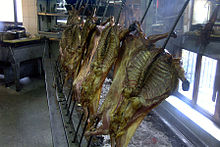 Cabrito (kid goat) is Monterrey's most popular traditional dish
Cabrito (kid goat) is Monterrey's most popular traditional dish
The most traditional dish from Monterrey is cabrito,[59] kid goat cooked on embers based on the Jewish cuisine of the founders of the city.[citation needed] Other local dishes and customs that perhaps date back to the Crypto-Judaism of these founders are the "semita" (bread without leavening), the capirotada dessert (a mix of cooked bread, cheese, raisins, peanuts, and crystallized sugarcane juice), and the relative absence of pork dishes. Another famous local dish is machacado con huevo.
Carne asada on weekends remains a tradition among Monterrey families. It is usually served with grilled onions, baked potatoes and sausages or chopped as tacos. Locally brewed beer and cola are an almost mandatory part of the weekly ritual. The traditional desserts, "glorias" and "obleas," made from goat milk are both traditional candies from Nuevo León.
Sports
- See also articles in the category Sport in Monterrey
Rayados play in the Estadio Tecnológico stadium.
Monterrey has two football teams in the Mexican league, the Club de Fútbol Monterrey, known as Rayados de Monterrey, which uses Estadio Tecnológico, a facility owned by the ITESM rented to the team, to host matches. And the Tigres de la UANL, owned by CEMEX,[60] which hosts matches at Estadio Universitario, at the main campus of the UANL. Both teams are related to the city on the derby, called Clásico Regiomontano. There was a proposed project to build a stadium for both teams, the "Estadio Internacional Monterrey",[61] but the idea was dropped out by both teams. The project is still being promoted, and the city is giving a positive view of it, but the UANL Tigres have yet to finish their stadium contract and the Rayados are planning a stadium of their own. Club de Fútbol Monterrey plans to build a new stadium able to sit a crowd of 50,000. It was scheduled to be finished by 2011, named "Estadio de Fútbol Monterrey". The new stadium is to be financed by the club's managing firm, FEMSA, and will remain the club's property for fifty years before becoming property of the government. The project has been in a hiatus for almost three years due to political bureaucracy, and is expected to get back on track by summer 2011.[62] The city hosted 8 matches during the 1986 FIFA World Cup.[63]
In addition, two professional indoor soccer teams were hosted in the past, the Monterrey La Raza, members of the Continental Indoor Soccer League and World Indoor Soccer League and the Monterrey Fury, members of the current Major Indoor Soccer League. The city was awarded another franchise to begin play in the fall of 2007 in the MISL.
Baseball has a long history in the city, where it became the most popular sport during the early 20th century. Monterrey has been champion of the Little League World Series three times (1957, 1958 and 1997), and has been host of US Major League Baseball games. In the Mexican Baseball League, the Sultanes de Monterrey are one important team every season and have won the national title several times. In the year 2003, the city unsuccessfully attempted to buy (and relocate to Monterrey) the Montreal Expos franchise of the US Major League Baseball.The Sultanes de Monterrey, are a Mexican League baseball team based in Monterrey, Mexico. They are in the Northern Division. The team was formed May 20, 1939 as Carta Blanca (A local beer brand, owned by Cuauhtémoc Moctezuma Brewery which owned the team). The team was also known as the gray ghosts. Soon, they became one of the most important teams in the league, winning its first championship in 1943. The Sultanes play in the Estadio de Béisbol Monterrey, the largest baseball stadium in Mexico.[64]
There are two professional basketball teams: Fuerza Regia that plays in the national league, Liga Nacional de Baloncesto Profesional and the Monterrey Venom that plays in the minor league American Basketball Association. Fuerza Regia plays at the Monterrey Arena while the Monterrey Poison plays at the gymnasium of the ITESM.
The city has hosted the Champ Car race in Fundidora Park from 2001 to 2005 and hosted the A1 Grand Prix of Nations on February 2006.
In 2004 Monterrey hosted the World Karate Federation Senior World Championships. In April 2004, Monterrey's Arena Monterrey became the first city to host WWE in Mexico. In 2007 Monterrey hosted the Women's WTBA World Tenpin Bowling Championships
The city has two college American football teams, the Auténticos Tigres (UANL) and the Borregos (ITESM) that play in the National College League (ONEFA). There is also a local children's league called AFAIM.
People can also find golf, fishing, camping, and extreme-sports outdoors near the city (bungee jumping at Cola de Caballo, rock-climbing, hiking, mountain bike). In particular there is international-level rock-climbing places like la Huasteca, Potrero Chico and many other canyons.
Starting 2009 the Monterrey Open is held at Monterrey. This is a professional women's tennis tournament. The event is affiliated with the Women's Tennis Association (WTA), and is be part of the International tournaments on the WTA Tour.
In 2010, Monterrey hosted the International Ice Hockey Federation World U18 Championship at the Monterrey Ice Complex.
As for the Rugby in 2010, Centauros Rugby Club Monterrey is founded which is currently affiliated with the FMRU (Federacion Mexicana de Rugby).
Monterrey is currently bidding for the 2018 Summer Youth Olympics.[65]
Contemporary music
- See also articles in the category Musical groups from Monterrey
Starting in the 1960s, Monterrey has been known for "Norteño" music which is the trademark music of the city, bands like Ramon Ayala, Pesado, Duelo and other Mexican "Regional" music bands perform at the different clubs in the city. Monterrey has witnessed the birth of several bands that have become internationally acclaimed. Their genres vary considerably. Bands include Plastilina Mosh, Control Machete, Kinky, El Gran Silencio, Jumbo, Panda, Genitallica. The song "Los Oxidados" by Plastilina Mosh opened the 2005 movie Mr. & Mrs. Smith. Kinky performed at the 2004 edition of the Coachella Valley Music and Arts Festival in California, along with Radiohead, The Cure and The Killers.
Landmarks
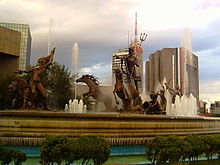 The Macroplaza
The Macroplaza
- Santa Lucia Riverwalk, an artificial river built between 1996 and 2007. It currently joins the Macroplaza with the Fundidora Park.
- The Cerro de la Silla (Saddle Mountain).
- La Macroplaza, one of the world's largest plazas,[citation needed] is the cultural and administrative heart of the city featuring remarkable monuments, green areas and buildings.
- Faro del Comercio (Lighthouse of Commerce), another trademark of the city. This monuments beams a green laser around the city at night.
- Barrio Antiguo (old neighborhood), area where bars, cafes, art galleries and restaurants can be found. On November of every year the Festival Cultural Barrio Antiguo took place with national and international artists and performers, but now is replaced with the Festival Internacional de Santa Lucia, which now takes place in September.
- The Museum of Modern Art is a post-modern Mexican architecture designed by Ricardo Legorreta with the objective of creating different ambiances for artists and visitors from all around the world.
- Monterrey's Inukshuk is one of only a handful of authentic examples to be found outside Canada of these stone monuments from the high Arctic. The sculpture was created in situ by the renowned Inuit artist Bill Nasogaluak in 2007 and was a gift to the state of Nuevo León from the Canadian Chamber of Commerce and the Government of Canada.
- Fundidora Park is a large urban park that contains old foundry buildings, 120 hectares of natural ambiance, artificial lakes, playgrounds, alternative cinema (Cineteca), museum (Photo Collection, the State Plastic Arts Collection, Exhibits and Spaces), hotel, auditorium and convention center.
- Puente de la Unidad (sometimes called Puente Atirantado) is a suspension bridge that crosses the Río Santa Catarina and joins San Pedro Garza García with Monterrey.
- The Alfa Planetarium is the first IMAX dome built in Latin America and fourth in the world.
- The Government Palace of Nuevo León is a pink marble of Neoclassical architecture where the governor's office is located.
- El Cerro del Obispado (Bishopric Hill) which includes a public, scenic lookout called Mirador del Obispado, a Monumental flag and the museum inside the Palacio del Obispado (the Bishopric Palace).
- ITESM, ITESM has two distinctive buildings CEDES which houses the administration of the ITESM nationwide system and the CETEC which houses the main computer classroom and other offices.
- Cuauhtémoc Moctezuma Brewery (Cervecería Cuauhtémoc Moctezuma), with its 19th century buildings and where the national Baseball Hall of Fame (Salón de la Fama) is located.
- The Cola de Caballo (Horse tail) waterfall, on the mountains near the towns of Santiago and El Cercado, about 35 km (22 mi) south.
- On the way to the Cola de Caballo waterfall (Carretera Nacional going to Ciudad Victoria, Tamaulipas), in Santiago, the Presa Rodrigo Gomez or "La Boca" ("La Boca" Dam)[66][67] lays nested between green hills.
Broadcasting and media
Monterrey is an important producer and broadcaster of media and entertainment in Mexico. Grupo Multimedios operates 2 television channels in the city, one of them broadcasting also to the Mexican states of Coahuila, Tamaulipas, Veracruz, Chihuahua and Guanajuato, and to several cities in the United States. Televisa and TV Azteca, the two only national television networks, have local stations in the city.
Grupo Reforma, one of the most widely read newsources in Mexico originated in the city with the newspaper El Norte. Milenio Diario de Monterrey, published by Grupo Multimedios, is another newspaper of high distribution, daily printing local editions in the most important Mexican cities. Other local newspapers include El Porvenir and ABC. Northern Mexico's weekly business newspaper Biznews is also headquartered in Monterrey.
Monterrey also has several radio stations broadcasting news, music, entertainment, and culture for the city. The main radio broadcasting groups are Multimedios Radio, Grupo Radio Alegría and Nucleo Radio Monterrey.
There are 11 free-to-air TV channels broadcasting in the city:
International development
The 2007 Universal Forum of Cultures was an international cultural event held in Monterrey from September 20 to December 8, 2007.[68]
Also the city wanted to bid for the 2016 Summer Olympics,[69] but the Mexican Olympic Committee refused to support it.[70] The city council are now bidding for the 2020 Olympic games.[71]
Backed by a young people's movement, students of the universities of Monterrey formed the Monterrey 2014 Foundation with the purpose of hosting the 2014 Summer Youth Olympics. In 2009 the Mexican Olympic Committee gave the bid to Guadalajara which later on withdrew the bid late January 2010.[72] Monterrey is now bidding for the 2018 Summer Youth Olympics.[73][74]
Notable people
Main article: Notable people from MonterreyInternational relations
See also: List of twin towns and sister cities in MexicoTwin towns – Sister cities
Monterrey is twinned with:
Call sign Network CH Contents Type XEFB Teleactiva 2 Entertainment regional XHWX Azteca 13 4 Entertainment regional XET Canal 5 6 Entertainment local XHFN Azteca 7 7 Series, Movies regional XHX Canal de las Estrellas 10 Entertainment, News local XHAW Multimedios 12 Entertainment, News flagship XHMOY Galavisión 22 Entertainment local XHMNL TVNL 28 Cultural, News local XHCNL Monterrey Televisión 34 Entertainment, News regional XHMNU UANL 53 Cultural local XHSAW Multimedios 64 Entertainment local  Arica, Chile
Arica, Chile Barcelona, Spain[75]
Barcelona, Spain[75] Corpus Christi, USA
Corpus Christi, USA Dallas, USA
Dallas, USA General Santos City, Philippines
General Santos City, Philippines Munich, Germany
Munich, Germany
 Rosario, Argentina
Rosario, Argentina San Antonio, USA
San Antonio, USA Shawinigan, Canada
Shawinigan, Canada Shenyang, China
Shenyang, China Dubai, United Arab Emirates
Dubai, United Arab Emirates Trujillo, Peru
Trujillo, Peru
References
- ^ a b c "Ubicación Geográfica". Gobierno del Estado de Nuevo León. http://www.nl.gob.mx/?P=ubicacion_geografica. Retrieved June 24, 2009.
- ^ "2010 INEG Census Tables". INEG. http://mapserver.inegi.org.mx/mgn2k/?s=geo&c=1223. Retrieved June 4, 2011.
- ^ a b c "NAI Mexico Study" (PDF). NAI Mexico. http://www.naidirect.com/market_research/pguide2006/monterrey.pdf. Retrieved January 7, 2009.
- ^ a b c Emmot, Robert (June 1, 2011). "Special report: If Monterrey falls Mexico falls – Rueters". Rueters.
- ^ "Global city GDP rankings 2008–2025". Pricewaterhouse Coopers. Archived from the original on May 31, 2010. https://www.ukmediacentre.pwc.com/Content/Detail.asp?ReleaseID=3421&NewsAreaID=2. Retrieved December 16, 2009.
- ^ Contreras, Joseph (2009). In the shadow of the giant: the Americanization of modern Mexico. Rutgers University Press. pp. 276. http://books.google.com/books?id=q222UYDAaSkC&pg=PA184&lpg=PA184&dq=monterrey+americanized+city&source=bl&ots=ZWfAR6vK7P&sig=jPm_jtv5ZvyqFrvd4PaF1ikpZFI&hl=en&ei=gfWyTqHeHajg0QHLuvjJDA&sa=X&oi=book_result&ct=result&resnum=6&ved=0CEcQ6AEwBQ#v=onepage&q=monterrey%20americanized%20city&f=false.
- ^ Rovelo, Carlos A. (2002). "Breeding success in Monterrey: Mexico's industrial powerhouse provides an end market for many secondary commodities – 2002 Latin-American Markets Supplement". BNET. http://findarticles.com/p/articles/mi_m0KWH/is_9_40/ai_92724941/?tag=content;col1. Retrieved July 1, 2009.
- ^ "Beer Me! – Cervecería Cuauhtémoc-Moctezuma – Monterrey, Nuevo León, México". beerme.com. http://beerme.com/brewery.php?1169. Retrieved July 1, 2009.
- ^ "Journal of Business Research: Carrier Mexico S.A. de C.V." (Web/PDF). [www.sciencedirect.com ScienceDirect]. http://www.sciencedirect.com/science?_ob=ArticleURL&_udi=B6V7S-417FB6N-C&_user=10&_rdoc=1&_fmt=&_orig=search&_sort=d&_docanchor=&view=c&_searchStrId=945653660&_rerunOrigin=google&_acct=C000050221&_version=1&_urlVersion=0&_userid=10&md5=af905e9d93ea0ef91f38d8cca23d9e92. Retrieved July 1, 2009.[dead link]
- ^ "Teleperformance Mexico S.A. de C.V.". goliath.ecnext.com. http://goliath.ecnext.com/coms2/product-compint-0001221400-page.html. Retrieved July 1, 2009.
- ^ "Historia – Nuevo León". e-local.gob.mx. http://www.e-local.gob.mx/work/templates/enciclo/nuevoleon/hist.htm. Retrieved July 2, 2009.
- ^ Parque Fundidora[dead link]
- ^ "Republicano Ayuntamiento". Municipio de Monterrey. Archived from the original on January 25, 2007. http://web.archive.org/web/20070125130657/http://www.monterrey.gob.mx/cabildo/. Retrieved December 14, 2007.
- ^ América Economía (Business Magazine), page 32, issue of May 2005
- ^ "BBC NEWS". news.bbc.co.uk. March 21, 2009. http://news.bbc.co.uk/1/hi/world/americas/7956782.stm. Retrieved July 1, 2009.
- ^ "Drug cartel hitman arrested". Straits Times. Singapore. http://www.straitstimes.com/Breaking%2BNews/World/Story/STIStory_353190.html. Retrieved July 1, 2009.[dead link]
- ^ "UPDATE 18: Horrible News From Monterrey, Mexico and Beyond... Marijuana Legalization Solution? – Austin, TX, United States, myFOXaustin Blog post – myfoxaustin community blogs". community2.myfoxaustin.com. http://community2.myfoxaustin.com/_UPDATE-18-Horrible-News-From-Monterrey-Mexico-and-Beyond-Marijuana-Legalization-Solution/BLOG/211413/82263.html. Retrieved July 1, 2009.[dead link]
- ^ Government of Monterrey Website Archived October 13, 2006 at the Wayback Machine
- ^ "Secretaría de Seguridad Pública". Nl.gob.mx. http://www.nl.gob.mx/?P=sec_seg_publica. Retrieved April 17, 2011.
- ^ "Sistema para la Consulta del CEM Monterrey, Nuevo León, Edición 2006 – Aspectos Geográficos (spanish)" (XLS). INEGI. 2006. http://www.inegi.org.mx/est/contenidos/espanol/sistemas/cem06/info/nln/m039/c19039_01.xls. Retrieved July 1, 2009.
- ^ "Ecological Sciences | United Nations Educational, Scientific and Cultural Organization". Unesco.org. http://www.unesco.org/mab/BRs/LacBRlist.shtml. Retrieved April 17, 2011.
- ^ Chipinque Ecological Park website[dead link]
- ^ Instituto Mexicano de Recursos Naturales Renovables[dead link]
- ^ "Siguen en defensa de La Huasteca". El Porvenir. http://www.elporvenir.com.mx/notas.asp?nota_id=117985. Retrieved April 17, 2011.
- ^ "Realizarán protestas ciudadanas contra Valle de Reyes". El Porvenir. http://www.elporvenir.com.mx/notas.asp?nota_id=127001. Retrieved April 17, 2011.
- ^ "La Estanzuela Parque Natural". Naba.org. http://www.naba.org/chapters/nabast/Estanzuela.html. Retrieved April 17, 2011.
- ^ "National and Local Weather Forecast, Hurricane, Radar and Report". Weather.com. http://weather.com/. Retrieved April 17, 2011.
- ^ Historical Weather for Monterrey, Mexico. Weatherbase.com. Retrieved December 18, 2006.
- ^ William R. Winkler. "The Weather And Circulation Of January 1967." Monthly Weather Review, Volume 95, Issue 4, April 1967
- ^ a b c "Sistema para la Consulta del CEM Monterrey, Nuevo León, Edición 2006 – Población (Spanish)" (XLS). INEGI. 2006. http://www.inegi.org.mx/est/contenidos/espanol/sistemas/cem06/info/nln/m039/c19039_03.xls. Retrieved July 1, 2009.
- ^ a b 1746, Farnham, Thomas J. Mexico: Its Geography, its people and its institutions. New York, 1846; Mexico: The Country, History and People. London, 1863.
- ^ a b 1862 a/ – Durán, Rafael. "Memorias sobre el censo de la República", en Boletín de la Sociedad Mexicana de Geografía y Estadística. México, 1862.
- ^ a b 1900 a 1940 – Censos Generales de Población.
- ^ a b 1995 – INEGI. Conteo de Población y Vivienda, 1995.
- ^ "Delimitación de las zonas metropolitanas de México" (PDF). http://www.inegi.gob.mx/est/contenidos/espanol/metodologias/otras/zonas_met.pdf. Retrieved April 17, 2011.
- ^ http://www.nl.gob.mx/?P=t_tur_sertur_trans_metro
- ^ "> Central America > Mexico > Monterrey Metro". UrbanRail.Net. http://www.urbanrail.net/am/mony/monterrey.htm. Retrieved July 14, 2009.[dead link]
- ^ Passenger statistics for Monterrey Airport in 2006 http://www.oma.bz/EN/BoletinesDePrensa.asp?idAeropuerto=mty
- ^ "Anuncian reactivación del vuelo Monterrey-Nueva York de Aeroméxico". Gobierno del Estado de Nuevo León, México. 2005. http://www.nl.gob.mx/?Article=51786&ArtOrder=ReadArt&P=leerarticulo&Page=1. Retrieved July 6, 2008. "Cantú Valderrama añadió que con esto, fuera de la Ciudad de México y de los viajes charters a Cancún, Quintana Roo, Monterrey es el aeropuerto más importante en el interior de la República."
- ^ "Mexico Staying Healthy in Mexico". solutionsabroad.com. http://www.solutionsabroad.com/en/living/living-category/staying-healthy-in-mexico.html. Retrieved July 18, 2009.
- ^ "All About Monterrey, Mexico". medicaltourismmag.com. http://www.medicaltourismmag.com/issue-detail.php?item=69&issue=4. Retrieved July 18, 2009.
- ^ "MONTERREY HEALTHCARE CITY ~ TALENT AND TECHNOLOGY TO TREAT YOU". medicaltourismmag.com. http://www.medicaltourismmag.com/issue-detail.php?item=90&issue=4. Retrieved July 18, 2009.
- ^ "Good care, low prices lure patients to Mexico | Dallas Morning News | News for Dallas, Texas | Mexico News". Dallasnews.com. July 28, 2007. Archived from the original on May 6, 2008. http://web.archive.org/web/20080506173732/http://www.dallasnews.com/sharedcontent/dws/news/world/mexico/stories/DN-hospitals_28int.ART0.State.Edition2.424104e.html. Retrieved July 14, 2009.
- ^ City Mayors. Retrieved April 4, 2009.
- ^ a b "Business Opportunities in Monterrey – U.S. Commercial Service Mexico". buyusa.gov. http://www.buyusa.gov/mexico/en/business_monterrey.html. Retrieved June 30, 2009.
- ^ Coerver, Don M.; Pasztor, Suzanne B.; Buffington, Robert (August 31, 2004). Mexico: an Encyclopedia of contemporary culture and history. ABC-CLIO Ltd. p. 305. ISBN 978-1-57607-132-8. http://books.google.com/?id=YSred4NyOKoC&pg=PA305&lpg=PA305&dq=Monterrey+%22the+%5B%5BPittsburgh%5D%5D+of+Mexico%22.
- ^ Mexico Connect. North star shines. Retrieved February 11, 2006.
- ^ "Fundidora Monterrey Blast Furnaces – UNESCO World Heritage Centre". whc.unesco.org. http://whc.unesco.org/en/tentativelists/5393/. Retrieved June 30, 2009.
- ^ "RMC takeover would transform Cemex into 20 million+ yd. U.S. ready mixed gigante". cementamericas.com. http://cementamericas.com/mag/cement_rmc_takeover_transform/. Retrieved June 30, 2009.[dead link]
- ^ Weldmex General information. Retrieved February 11, 2006.
- ^ a b Country-data. Mexico – Industry. Retrieved February 11, 2006.
- ^ "Mercer Human Resource Consulting (2006)". Mercerhr.com.pr. http://www.mercerhr.com.pr/pressrelease/details.jhtml/dynamic/idContent/1222465;jsessionid=HBZKUMSRFA5FKCTGOUGCHPQKMZ0QUJLW. Retrieved April 17, 2011.
- ^ a b "Sistema para la Consulta del CEM Monterrey, Nuevo León, Edición 2006 – Educación, Cultura y Deporte (Spanish)" (XLS). INEGI. http://www.inegi.org.mx/est/contenidos/espanol/sistemas/cem06/info/nln/m039/c19039_06.xls. Retrieved July 2, 2009.
- ^ "Life in Monterrey – Education". cegs.itesm.mx. Archived from the original on February 26, 2004. http://web.archive.org/web/20040226035040/http://www.cegs.itesm.mx/pi/teaching/life/education.html. Retrieved June 30, 2009.
- ^ UANL Website About UANL Archived March 7, 2009 at the Wayback Machine
- ^ UANL Website Location of UANL Archived April 26, 2009 at the Wayback Machine
- ^ "Universidad Autónoma de Nuevo León. Facultad de Medicina". Medicina.uanl.mx. March 30, 2011. http://www.medicina.uanl.mx/. Retrieved April 17, 2011.
- ^ "UDEM – About UDEM". udem.edu.mx. http://www.udem.edu.mx/XStatic/udem/template/msdetallenota.aspx?ms=english&st=2064&sTema=History&ssTema=UDEM%20founders. Retrieved June 30, 2009.
- ^ Live Better South of the Border in ... – Google Books. books.google.co.uk. July 19, 2005. ISBN 978-1-55591-546-9. http://books.google.com/?id=jZ4I92OHP90C&pg=PT168&dq=cabrito+al+pastor+Monterrey. Retrieved June 30, 2009.
- ^ "Cemex Hard Times May Get Tougher If Soccer Team Falls to Minors". Bloomberg. http://www.bloomberg.com/apps/news?pid=20601079&sid=as7oVWUYzeHw. Retrieved July 3, 2009.
- ^ "Official Site". Estadiointernacionalmonterrey.com. http://www.estadiointernacionalmonterrey.com. Retrieved April 17, 2011.
- ^ "C.F. Monterrey – Wikipedia, the free encyclopedia". En.wikipedia.org. Archived from the original on March 28, 2009. http://web.archive.org/web/20090328114004/http://en.wikipedia.org/wiki/Rayados#Stadium. Retrieved July 14, 2009.
- ^ "Planet World Cup – 1986 – Results". PlanetWorldCup.com. http://www.planetworldcup.com/CUPS/1986/wc86index.html. Retrieved July 3, 2009.
- ^ "Sultanes de Monterrey". http://www.baseball-reference.com/bullpen/Monterrey_Sultan. Retrieved October 18, 2007.[dead link]
- ^ http://www.insidethegames.biz/olympics/youth-olympics/2018/12783-monterrey-steps-up-bid-for-2018-summer-youth-olympics
- ^ "Presa de La Boca". Tododemonterrey.com. http://www.tododemonterrey.com/excursiones.htm#Presa%20de%20La%20Boca. Retrieved April 17, 2011.
- ^ "Local | Proyectan Parque Acuático en Presa de La Boca". El Porvenir. http://www.elporvenir.com.mx/notas.asp?nota_id=45394. Retrieved July 14, 2009.
- ^ "Fórum Universal de las Culturas 2007". monterreyforum2007.org. http://www.monterreyforum2007.org/index.php. Retrieved June 30, 2009.
- ^ "GamesBids.com – Monterrey Mexico Considers 2016 Summer Olympic Bid". gamesbids.com. http://www.gamesbids.com/eng/other_news/1150304681.html. Retrieved June 30, 2009.
- ^ "GamesBids.com – Mexico's Olympic Committee Rejects Monterrey's 2016 Olympic Bid". gamesbids.com. http://www.gamesbids.com/eng/index.php?news=1189691186. Retrieved June 30, 2009.
- ^ "2020 Summer Olympics". turkey2020.info. http://www.turkey2020.info/. Retrieved June 30, 2009.
- ^ [1][dead link]
- ^ Monterrey steps up bid for 2018 Summer Youth Olympics
- ^ [2] Monterrey 2014
- ^ "Barcelona internacional – Ciutats agermanades" (in Catalan). 2006–2009 Ajuntament de Barcelona. http://w3.bcn.es/XMLServeis/XMLHomeLinkPl/0,4022,229724149_257215678_1,00.html. Retrieved July 13, 2009.
- ^ "Hamilton Ontario Sister Cities". Archived from the original on September 26, 2007. http://web.archive.org/web/20070926234112/http://www.myhamilton.ca/myhamilton/CommunitiesAndOrganizations/communitiesofhamilton/sistercities. Retrieved January 25, 2008.
Further reading
- Michael Snodgrass, Deference and Defiance in Monterrey: Workers, Paternalism, and Revolution in Mexico, 1890–1950 (Cambridge University Press, 2003) (ISBN 978-0-521-81189-7)
External links
Coordinates: 25°40′N 100°18′W / 25.667°N 100.3°W
 State of Nuevo LeónMonterrey (capital)
State of Nuevo LeónMonterrey (capital)Topics Architecture · Climate · Cuisine · Culture · Demographics · Economy · Education · Geography · Government · History · Literature · Politics · Sports · New Leonese · Transportation · Tourist Attractions

Municipalities/
townsAbasolo · Agualeguas · Allende · Anáhuac · Apodaca · Aramberri · Bustamante · Cadereyta Jiménez · El Carmen · Cerralvo · China · Ciénega de Flores · Doctor Arroyo · Doctor Coss · Doctor González · Galeana · García · General Bravo · General Escobedo · General Terán · General Treviño · General Zaragoza · General Zuazua · Guadalupe · Hidalgo · Higueras · Hualahuises · Iturbide · Juárez · Lampazos de Naranjo · Linares · Los Aldama · Los Herrera · Los Ramones · Marín · Melchor Ocampo · Mier y Noriega · Mina · Montemorelos · Monterrey · Parás · Pesquería · Rayones · Sabinas Hidalgo · Salinas Victoria · San Nicolás de los Garza · San Pedro Garza García · Santa Catarina · Santiago · Vallecillo · Villaldama
Regions of Nuevo León Monterrey metropolitan area · Peripheral Region · Northern Nuevo León · Salinas Valley · Citrícola Region · Pilón Valley · Southern Nuevo León · Río Blanco Valley
Monterrey Metropolitan Area Monterrey · Apodaca · Escobedo · García · Guadalupe · Juárez · Salinas Victoria · San Nicolás de los Garza · San Pedro Garza García · Santa Catarina · Santiago
 Mexican state capitalsAguascalientes (Aguascalientes) · Mexicali (Baja California) · La Paz (Baja California Sur) · Campeche (Campeche) · Tuxtla Gutiérrez (Chiapas) · Chihuahua (Chihuahua) · Saltillo (Coahuila) · Colima (Colima) · Mexico City (DF) · Durango (Durango) · Guanajuato (Guanajuato) · Chilpancingo (Guerrero) · Pachuca (Hidalgo) · Guadalajara (Jalisco) · Toluca (Mexico State) · Morelia (Michoacán) · Cuernavaca (Morelos) · Tepic (Nayarit) · Monterrey (Nuevo León) · Oaxaca (Oaxaca) · Puebla (Puebla) · Querétaro (Querétaro) · Chetumal (Quintana Roo) · San Luis Potosí (San Luis Potosí) · Culiacán (Sinaloa) · Hermosillo (Sonora) · Villahermosa (Tabasco) · Cd. Victoria (Tamaulipas) · Tlaxcala (Tlaxcala) · Xalapa (Veracruz) · Mérida (Yucatán) · Zacatecas (Zacatecas)Categories:
Mexican state capitalsAguascalientes (Aguascalientes) · Mexicali (Baja California) · La Paz (Baja California Sur) · Campeche (Campeche) · Tuxtla Gutiérrez (Chiapas) · Chihuahua (Chihuahua) · Saltillo (Coahuila) · Colima (Colima) · Mexico City (DF) · Durango (Durango) · Guanajuato (Guanajuato) · Chilpancingo (Guerrero) · Pachuca (Hidalgo) · Guadalajara (Jalisco) · Toluca (Mexico State) · Morelia (Michoacán) · Cuernavaca (Morelos) · Tepic (Nayarit) · Monterrey (Nuevo León) · Oaxaca (Oaxaca) · Puebla (Puebla) · Querétaro (Querétaro) · Chetumal (Quintana Roo) · San Luis Potosí (San Luis Potosí) · Culiacán (Sinaloa) · Hermosillo (Sonora) · Villahermosa (Tabasco) · Cd. Victoria (Tamaulipas) · Tlaxcala (Tlaxcala) · Xalapa (Veracruz) · Mérida (Yucatán) · Zacatecas (Zacatecas)Categories:- Monterrey
- Monterrey metropolitan area
- Mexican state capitals
- Populated places established in 1596
- Populated places in Nuevo León
- 1596 in Mexico
Wikimedia Foundation. 2010.


